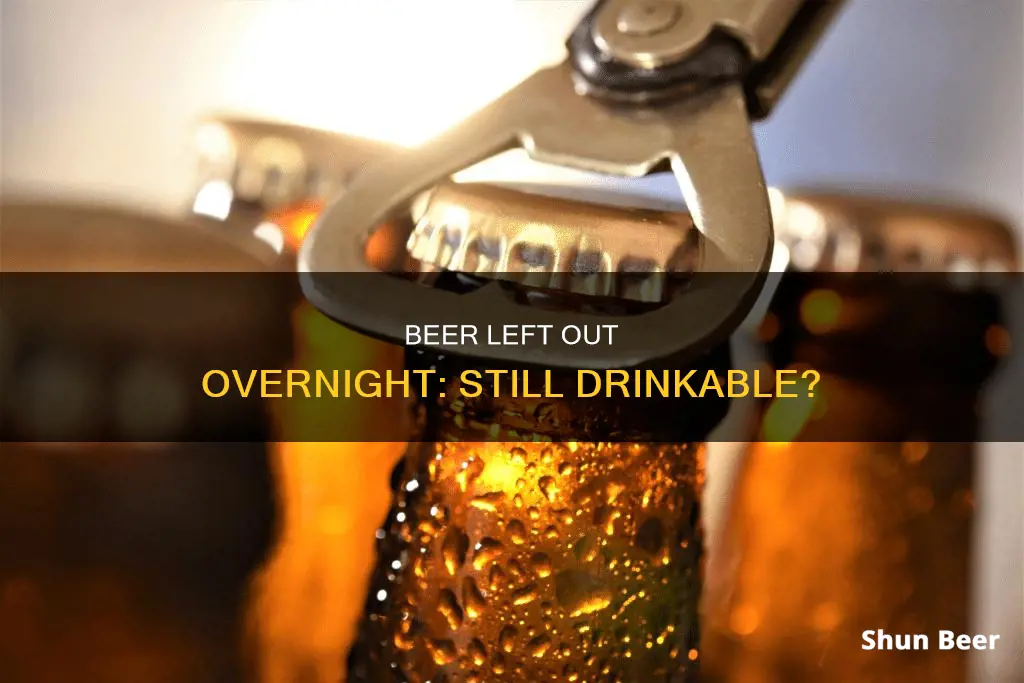
Whether you can drink beer that has been left out overnight is a question that haunts many. The answer depends on several factors, such as the type of beer, its alcohol content, and the storage conditions. Generally, unopened beer can last up to six months, while opened beer can last up to a few days to a week in the fridge. Beer that has been left out overnight can be consumed within 24-48 hours, but it is best to store it in a cool, dark place to maintain its quality.
When beer is exposed to air, it starts to lose its carbonation and can become flat and stale due to oxidation. Lighter beers, such as lagers and pilsners, are more vulnerable to higher temperatures, which accelerate spoilage. On the other hand, darker or higher-alcohol beers, like stouts and porters, are more resilient to temperature fluctuations due to their robust flavour profiles and the preservative effect of alcohol.
While drinking stale beer may not make you physically ill, it can affect your sense of taste and cause a stomachache. Additionally, beer left out for extended periods could potentially harbour bacteria and other microbes, making it unsafe for consumption. Therefore, it is important to inspect beer for any signs of spoilage, such as an unpleasant flavour, a musty smell, or visible mould, before consuming it.
What You'll Learn
- Beer can be left out overnight, but it's best consumed within 24-48 hours
- Beer loses flavour and goes flat within 30 minutes to 2 hours of being opened
- Higher alcohol content beers last longer than lighter beers
- Oxidation causes beer to go stale and flat
- Flat beer is generally safe to drink, but may not taste as good

Beer can be left out overnight, but it's best consumed within 24-48 hours
Beer is a delicate beverage, and its quality can be significantly impacted by factors such as temperature, exposure to light, and time. While it is generally recommended to consume beer soon after opening to maintain its optimal flavour and carbonation, leaving it out overnight won't necessarily ruin it.
Beer's Enemies: Time, Temperature, and Light
Oxidation is the primary enemy of beer quality. When beer is exposed to oxygen, it undergoes flavour degradation, resulting in a stale or flat taste. This process is accelerated by higher temperatures and exposure to light, particularly UV rays, which can cause a "lightstrike". Lighter beers, such as lagers and pilsners, are more susceptible to temperature fluctuations, while beers with higher hop content, like IPAs, are more prone to skunkiness from light exposure.
Beer's Friend: Alcohol
On the other hand, alcohol acts as a preservative, giving higher-ABV beers a longer shelf life. Even so, flavour changes are still possible, and proper storage is essential to slow the oxidation process.
Leaving Beer Out Overnight
If you accidentally leave your beer out overnight, it's not necessarily a cause for concern. Beer can be left out overnight but should be consumed within 24 to 48 hours for the best quality. During this time, it's important to store the beer in a cool, dark place to minimise oxidation and lightstrike.
Storing Opened Beer
To extend the life of an opened beer, it's recommended to refrigerate it immediately and seal it tightly with a stopper, plastic wrap, or a lid. This slows down oxidation and carbonation loss. However, reheating or re-refrigerating beer does not restore its freshness and can actually accelerate spoilage.
In summary, while it's best to consume beer soon after opening, leaving it out overnight is generally safe, provided it is consumed within the next 24 to 48 hours and stored in optimal conditions.
Beer Consumption: Is 4 Beers a Day Too Much?
You may want to see also

Beer loses flavour and goes flat within 30 minutes to 2 hours of being opened
Beer is a delicate beverage, and its flavour and quality can be significantly impacted by various factors, especially when left open. One of the critical aspects affecting beer is time; an open beer can start losing its flavour and going flat within 30 minutes to 2 hours. This process is accelerated by exposure to oxygen, which results in oxidation, causing the beer to go stale and lose its carbonation.
Oxidation is a significant concern for beer enthusiasts as it directly impacts the taste and aroma of their brew. The interaction with oxygen begins as soon as the beer is exposed to air, and the clock starts ticking on its freshness. The carbonation, or fizz, in beer is not just for show; it is integral to the overall character and experience of the beverage. The loss of carbonation over time, therefore, diminishes the beer's effervescence and makes it fall flat.
To prolong the life of an open beer, it is essential to minimise its exposure to oxygen. Proper storage plays a pivotal role in maintaining the beer's quality. Using a beer stopper, plastic wrap, or a rubber band can help create a barrier against air exposure, slowing down the oxidation process and preserving the beer's carbonation. Additionally, refrigeration is a beer's best friend. Keeping an open beer cold further slows down oxidation and the loss of carbonation, giving you a little more time to enjoy your drink.
While it is possible to salvage an open beer, it is a race against time and the elements. Even with proper storage, an open beer will only maintain optimal flavour and texture for 24 to 48 hours. After this timeframe, the beer will start to lose its freshness and develop a flat, unpleasant flavour. The type of beer also plays a role in its resilience; darker or higher-alcohol content beers, like stouts and porters, have a higher tolerance to temperature changes due to their robust flavour profiles and the preservative effect of alcohol.
Baclofen and Beer: Is It Safe to Mix?
You may want to see also

Higher alcohol content beers last longer than lighter beers
Beer can be left out overnight, but it is best to consume it within 24-48 hours. This is because, once opened, beer starts to go flat and the taste can become stale due to oxidation. The carbonation in beer is integral to its texture and taste, and once opened, carbonation is lost over time.
The type of beer and its alcohol content significantly influence its shelf life post-opening. Beers with lower alcohol content and delicate flavour profiles, such as wheat beers and light ales, are more prone to spoilage and flavour degradation when left open.
Beers with higher alcohol content, such as barley wines and imperial stouts, tend to have a longer shelf life, even after being opened. This is because the higher alcohol content acts as a natural preservative, extending the beer's shelf life.
However, it is important to note that while alcohol can help preserve beer, the nuanced flavours of these stronger brews can still change over time. Therefore, proper storage is essential for all beer types to maintain their intended flavour characteristics over time.
Lighter beers, such as lagers and pilsners, are particularly vulnerable to higher temperatures, which can accelerate spoilage by promoting faster oxidation and loss of carbonation. These beers are best kept in cooler environments to preserve their crisp and refreshing taste.
In summary, higher alcohol content beers tend to last longer than lighter beers due to the preservative effect of alcohol. However, all beers will eventually lose their optimal flavour and carbonation if left out overnight or for extended periods. Proper storage, such as refrigeration and sealing the bottle tightly, can help extend the shelf life of any beer.
Alcohol and Breastfeeding: Is Drinking Wine or Beer Safe?
You may want to see also

Oxidation causes beer to go stale and flat
Oxidation is a process that is generally considered ruinous to beer. It occurs when beer is exposed to oxygen, which can happen anywhere in the brewing process, from the brewhouse to the fermentation cellar, and even within the bottle during storage. The more oxygen a beer comes into contact with, the faster and more severe the oxidation.
Oxidation causes a chemical reaction that results in stale beer flavours. Beers that have undergone oxidation can take on many different flavours, and sometimes the oxidized sherry notes are indicative of a beer being "vintage", with sharp notes. However, most of the time, the oxidation encroaches on the other flavours of the beer. Some of the flavours that can be produced by oxidation include leathery, papery, wet cardboard-like, catty, and ribes or black currant. In hoppy beers, oxidation can kill all the hops and make the beer taste flat and muted.
The rate of oxidation is accelerated by an increase in the beer's storage temperature. For example, a beer kept at 6°C (42°F) may have a shelf life of 4 months, while the same beer kept at 30°C (86°F) may have a shelf life of less than 3 months. Additionally, heat and motion can work to accelerate oxidation. An improperly sealed cap or a cask or keg that has been left on tap too long can also cause oxidation in beer.
To prevent oxidation and maintain the quality of your beer, it is recommended to refrigerate the beer immediately after opening and seal it tightly with a stopper or plastic wrap.
Beer Drinking: A Culprit for High Uric Acid?
You may want to see also

Flat beer is generally safe to drink, but may not taste as good
Flat beer is generally safe to drink, but it may not taste as good. When beer is left out in the open, it loses carbonation and its flavour can degrade due to oxidation. This process can be slowed down by keeping the beer in a cool, dark place, such as a refrigerator, and by sealing it tightly with a stopper, plastic wrap, or a lid. However, even with proper storage, beer will lose its flavour and quality over time, and it is recommended to consume it within 24 to 48 hours for the best taste.
The absence of carbonation and the resulting flat taste are the main characteristics that set flat beer apart from regular beer. Carbonation gives beer its refreshing taste and mouthfeel, so flat beer may seem bland in comparison. Additionally, beer left out overnight may be affected by aerobic bacteria or yeast, further altering its flavour. While these changes may not be harmful, they can make the beer less enjoyable to drink.
To extend the shelf life of an open beer, it is important to minimise its exposure to oxygen, light, and bacteria. Storing it in an airtight container, such as a recycled plastic soda bottle, can help achieve this. Additionally, adding a few drops of sterile beer salts can create an environment where germs cannot thrive, which is especially beneficial for stronger alcoholic brews that are more prone to oxidation.
While flat beer is generally safe to consume, it is important to look out for signs of spoilage. Off-smells, such as a sour or acidic odour, a musty smell, or an unusual appearance can indicate bacterial contamination, which may pose health risks. Other signs of spoilage include cloudiness or sediment formation, and a marked shift in taste, such as excessive bitterness or sourness. If any of these signs are present, it is best to discard the beer.
In conclusion, flat beer is typically safe to drink, but it may not provide the same refreshing and flavourful experience as fresh beer. To maintain the quality and taste of beer, it is important to consume it promptly and store it properly when it is open.
Mixing Beer and Vodka: A Safe Drinking Guide
You may want to see also
Frequently asked questions
Yes, it is generally safe to drink a beer that has been left out overnight, but it's best to consume it within 24-48 hours.
The type of beer, alcohol content, and storage conditions all play a role in how long a beer can be left out. Lighter beers, such as lagers and pilsners, are more vulnerable to higher temperatures, while darker or higher-alcohol beers are more resilient.
When beer is exposed to oxygen, it can undergo oxidation, leading to flavour degradation and a stale or flat taste. Additionally, carbonation loss occurs over time, affecting the texture and taste of the beer.
To extend the shelf life of leftover beer, it is recommended to refrigerate it immediately and seal it tightly with a stopper or plastic wrap to minimise air exposure.
Spoiled beer may exhibit off-smells, colour changes, or a flat taste. In some cases, there may be visible haze or sediment formation. If the beer shows clear signs of spoilage, especially bacterial growth, it is best to avoid consuming it.







